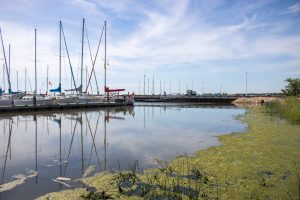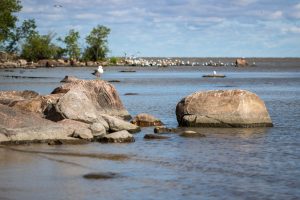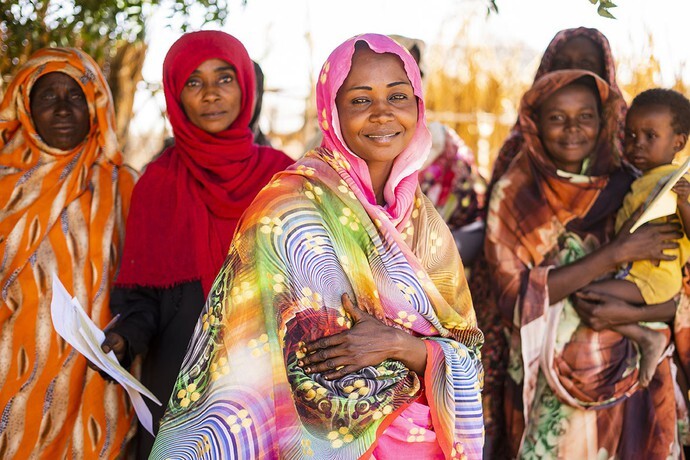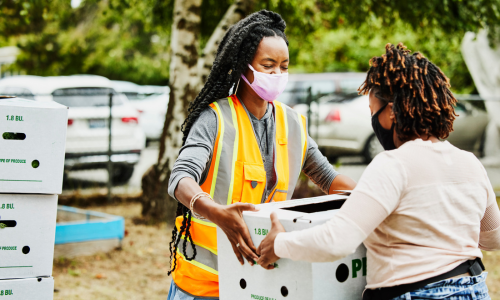This blog post was provided by Richard Farthing-Nichol from Centre for Indigenous Environmental Resources (CIER).

Lake Winnipeg is the tenth largest freshwater lake in the world, a prairie sea that communities and wildlife depend on for habitat, drinking water, recreation, fishing, and tourism — but the lake is dying. Toxic algae blooms, so big they can be seen from outer space, are a regular occurrence on the lake. The problem has been growing for years, and today, Lake Winnipeg is at a tipping point. Transformative solutions are urgently needed to begin reversing the damage and healing this great body of water.
Algae can have devastating impacts: it contaminates beaches, making them unpleasant and unsafe for swimming; affects the taste and odour of drinking water; clogs water intake pipes and fishing nets; and damages ecosystems and leads to fish die offs. The algae blooms on Lake Winnipeg pose a huge threat to Manitoba’s commercial fishing and tourism industries. The impacts are well-known, yet meaningful solutions have proven elusive.
At the Centre for Indigenous Environmental Resources (CIER), we are working to solve this wicked problem. Together with the Winnipeg Metropolitan Region and the Southern Chiefs’ Organization, we helped establish the Collaborative Leadership Initiative (CLI). CLI is reconciliation in action: for the first time in 153 years, municipal and First Nation leaders in southern Manitoba are sitting in the same room, as governments, working together to protect shared land and waters. Together, they are determined to save Lake Winnipeg before it’s too late.
The Challenge: Too Much Phosphorous
All plants need nutrients, such as phosphorous and nitrogen, to grow. But when nutrient levels in a body of water are too high, as they are in Lake Winnipeg, they can contribute to the excessive growth of harmful algae. The scale of this problem in Lake Winnipeg is enormous. Algae blooms of up to 15,000 square kilometres in size can develop on the lake. In 2013, Lake Winnipeg was listed as the most threatened lake in the world by the Global Nature Fund.
The key challenge in Lake Winnipeg is too much phosphorous. Phosphorous enters the lake from countless sources. Sewage, fertilizer from farmland, animal waste, some household detergents, and runoff from urban centres all contain phosphorous that can find its way into the lake. Some of this phosphorous comes from easily identifiable sources, such as a pipe flowing directly into a river. But most of it comes from harder to track sources, such as farmland that drains into rivers or streams across a large area.
This challenge is complicated by the sheer size of the Lake Winnipeg watershed. The watershed is massive, spanning nearly one million square kilometres and covering parts of four provinces, four U.S. states, and many Indigenous Nations. More than seven million people call the watershed home. How can we take coordinated action to reduce phosphorous across such a large and diverse area?
Collaboration is Key
An effective solution to save Lake Winnipeg must begin with collaboration. CLI is a partnership of 11 First Nation and 16 municipal communities in southern Manitoba. The communities are located just south of Lake Winnipeg and are each impacted by the deteriorating health of the lake. The CLI Leaders – 28 Chiefs, Mayors, and Reeves – realize that they must work together to reduce phosphorous loading across their region. In doing so, they are developing solutions that can be scaled up across the Lake Winnipeg watershed.
Our Natural Solution
The CLI Leaders’ solution is nature. Natural infrastructure such as wetlands, forests, and streambank vegetation are very effective at reducing the amount of nutrients in waterways. Natural infrastructure also provides other benefits, such as habitat for wildlife and recreational space for local communities. It can also help fight climate change by pulling carbon out of the atmosphere and building resilience to floods and droughts.

In the Lake Winnipeg watershed, a network of natural infrastructure could act as a powerful counterbalance to widespread phosphorous loading. Phosphorous enters the lake from many diverse and distributed sources – natural infrastructure provides a diverse and distributed solution to address this challenge. The CLI communities know their lands and waters better than anyone, and therefore they are best placed to plan and implement a network of natural infrastructure projects. The solutions they devise in their region could have a transformative impact across the Lake Winnipeg watershed.
How The Centre for Indigenous Environmental Resources is Helping
CIER has been co-leading CLI from the very beginning and will continue to support their efforts every step of the way. As the first and only Indigenous-led environmental non-profit charitable organization in Canada, CIER plays a unique role bridging Indigenous and western knowledge systems and perspectives. Since being created in 1995 by 10 Indigenous Chiefs, we have delivered research, advisory, education, and training services to over 400 Indigenous communities, governments, and private companies. Our work focuses on collaborating with Indigenous partners to develop the skills and information they need to steward their lands and waters according to their needs and values.
In our work with CLI, we led a structured reconciliation process that allowed the CLI Leaders to build relationships, dispel myths, share their histories, and reach common understanding. It is a powerful model of reconciliation that has set the stage for transformative solutions to save Lake Winnipeg. We are continuing to support the CLI Leaders as they begin implementing these solutions. This means helping to build natural infrastructure projects that reduce phosphorous and align with community values. It also means ensuring that these individual projects fit into a bigger vision that can eventually be scaled up across the Lake Winnipeg watershed.
CIER is proud to be supporting the CLI Leaders in this journey. However, securing funding for regional solutions is a persistent challenge. We need support to continue this work to clean up Lake Winnipeg, strengthen reconciliation, and advance the type of innovative collaboration needed to address complex environmental challenges.
Learn more and make a donation in support of Centre for Indigenous Environmental Resources (CIER) today.
Updated on November 4, 2024
Donate Now



